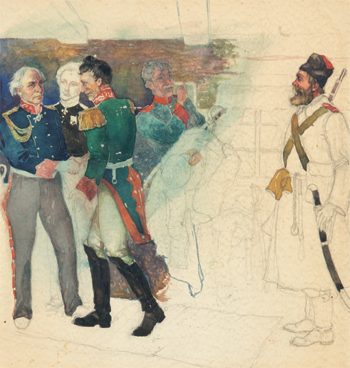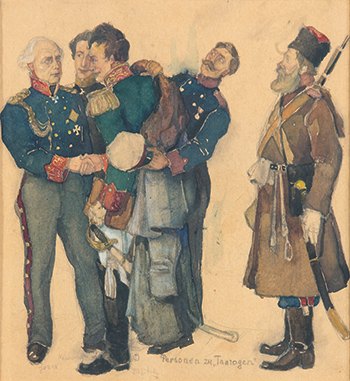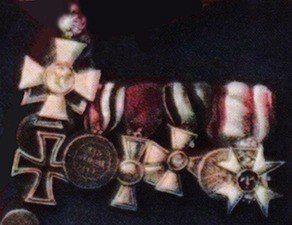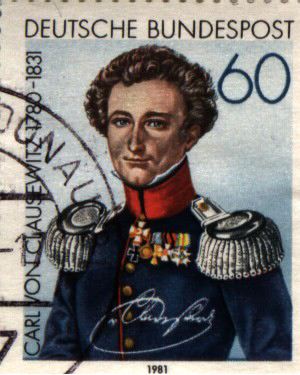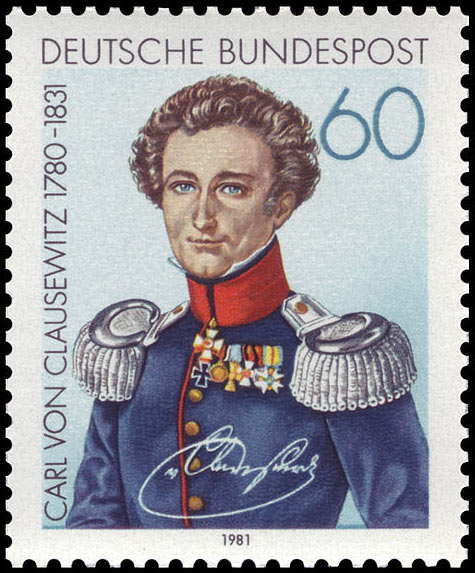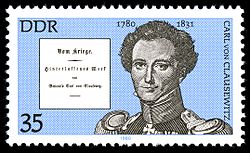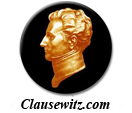
This is the "Historical Depictions" page of the "Clausewitz Graphics" section of Clausewitz.com. Other pages in the Graphics section include:
CLAUSEWITZ GRAPHICS (central page in Graphics section)
• Clausewitz: The Authentic Portraits (includes important derivatives)
• Caricatures
• 3D/Sculpture
• Humor & Cartoons
• Souvenirs
• Miscellaneous
• Images of A-H Jomini
• Clausewitz's Military Decorations
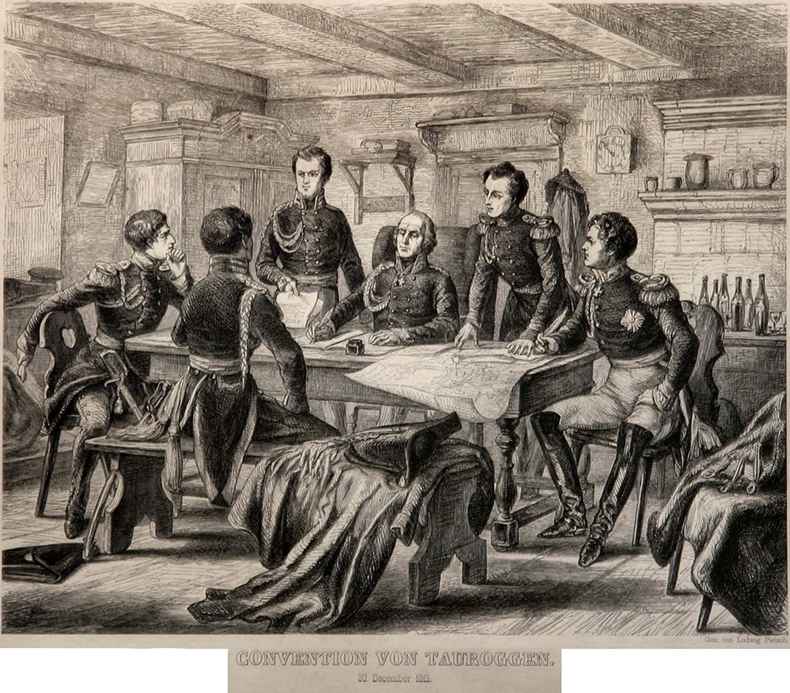 Clausewitz at Tauroggen. In December of 1812, during the French invasion of Russia, LTC Clausewitz (shown here in Russian uniform) played a key role in convincing the commander of Napoleon's Prussian contingent to neutralize his force (and eventually to switch sides). This event eventually forced the King of French-occupied Prussia to join the anti-Napoleonic alliance, which ultimately led to the resurrection of Prussia as a Great Power. The King was intensely annoyed at being forced to do the right thing. But that did not stop him from promoting Clausewitz to General a few years later. The detail below shows Clausewitz between Prussian General (later Generalfeldmarschall) Johann David Ludwig Graf Yorck von Wartenburg and the Russian Major-General (later Field Marshal) Hans Karl Friedrich Anton Graf von Diebitsch und Nartenas as Yorck signs the agreement. The drawing of Clausewitz is based on the Wilhelm Wach portrait painted 18 years later. This engraving by Ludwig Pietsch, based on an ink drawing, was printed c.1852. From the collection of the Stadtmuseum Leipzig.
Clausewitz at Tauroggen. In December of 1812, during the French invasion of Russia, LTC Clausewitz (shown here in Russian uniform) played a key role in convincing the commander of Napoleon's Prussian contingent to neutralize his force (and eventually to switch sides). This event eventually forced the King of French-occupied Prussia to join the anti-Napoleonic alliance, which ultimately led to the resurrection of Prussia as a Great Power. The King was intensely annoyed at being forced to do the right thing. But that did not stop him from promoting Clausewitz to General a few years later. The detail below shows Clausewitz between Prussian General (later Generalfeldmarschall) Johann David Ludwig Graf Yorck von Wartenburg and the Russian Major-General (later Field Marshal) Hans Karl Friedrich Anton Graf von Diebitsch und Nartenas as Yorck signs the agreement. The drawing of Clausewitz is based on the Wilhelm Wach portrait painted 18 years later. This engraving by Ludwig Pietsch, based on an ink drawing, was printed c.1852. From the collection of the Stadtmuseum Leipzig.
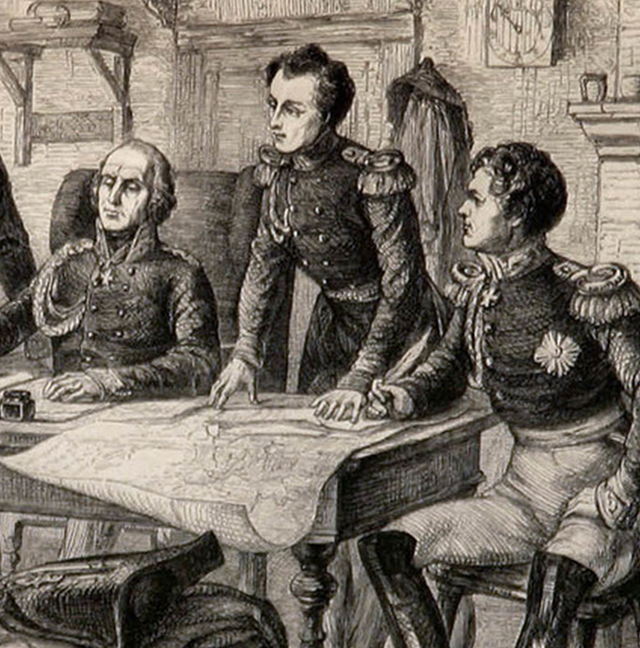
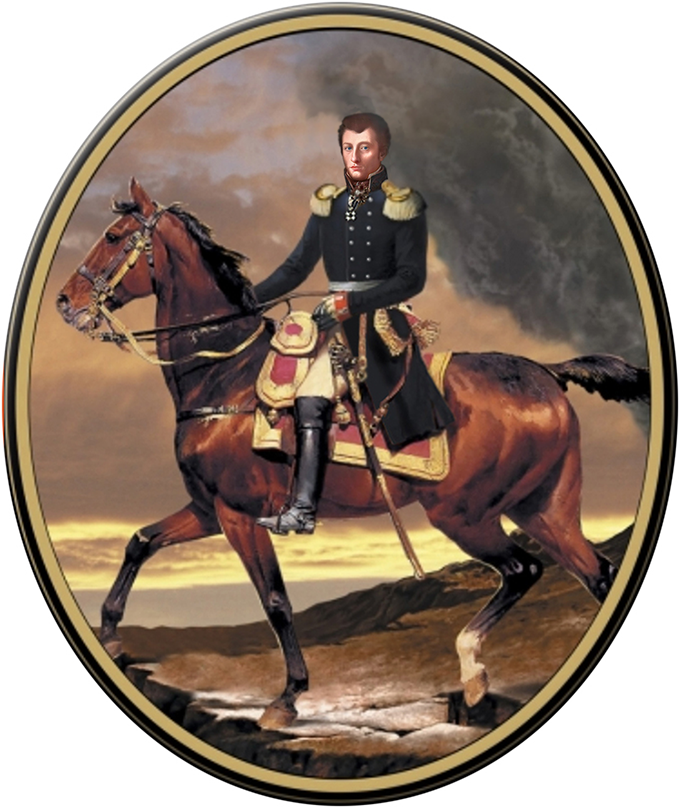 Clausewitz at the Battle of Borodino, Russia. Based on the c.1814 portrait.
Clausewitz at the Battle of Borodino, Russia. Based on the c.1814 portrait.
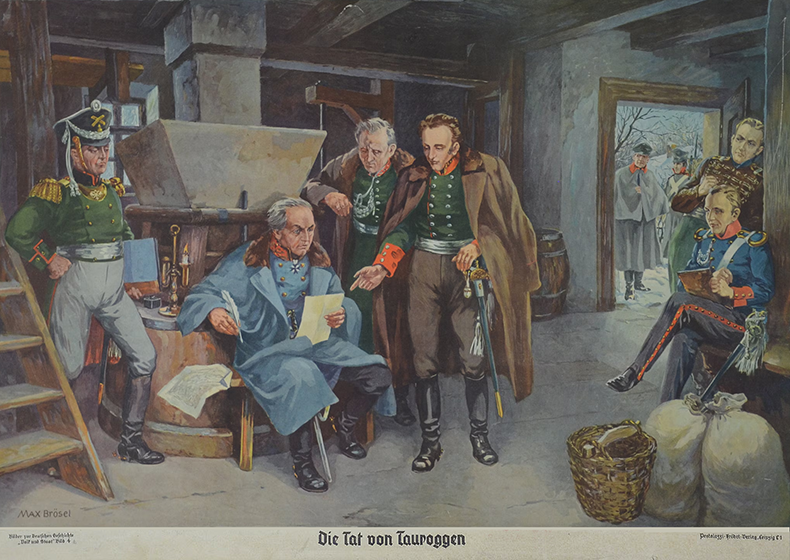 Another painting of Clausewitz at Tauroggen, 1812.
Another painting of Clausewitz at Tauroggen, 1812.
Click for a larger version.
Below: Two watercolor sketches, again showing Clausewitz interposing between Yorck and Diebitsch. The images below were painted in the 1950s by Georg Schlicht Stiftung, entitled "Entwurf zu Konvention zu Tauroggen 1812 (I & II)."
The painting shown below, entitled "Die Tafelrunde" (the roundtable) is by Josef Schneider (1966). It shows Clausewitz drinking with some prominent comrades in Mainz in 1815, when COL Clausewitz would have been about 35. It is displayed on the Clausewitz Homepage by courtesy of the Headquarters of the German Army Forces Command, Koblenz (HQ GARFCOM). They hold the copyright and have been known to supply high-quality photographs of it to facilitate high-quality print reproduction. It is based on a mirror-image of the Wach portrait. The painting below was made as a gift from the municipality to the Bundeswehr corps command in Koblenz in commemoration of the 150th anniversary of the existence of an army corps headquarters in the town. The painter, Josef Schneider, was living in the village Emmelshausen (25 km south of Koblenz) and got 3500 DM for his work. Schmidt cites Rüdiger Wischemann dissertation "Die 'Tafelrunde im von-der-Leyenschen Hof': ein Koblenzer Tafelbild von Josef Schneider, Emmelshausen" (Berlin, 2003), ISBN: 3898257576.
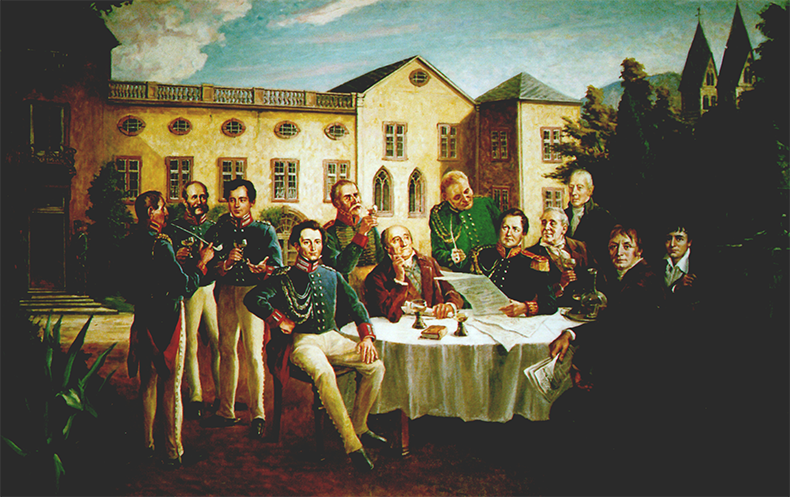 Click this picture for a larger (1500 pixels wide) image.
Click this picture for a larger (1500 pixels wide) image.
 This particular get-together is fictional, but the membership of this roundtable is representative of the VIII Corps command-group's social circle. Note the intellectuals; political figures with a wide range of differing views; artists; and soldiers with prominent careers ahead.
This particular get-together is fictional, but the membership of this roundtable is representative of the VIII Corps command-group's social circle. Note the intellectuals; political figures with a wide range of differing views; artists; and soldiers with prominent careers ahead.
1. Oberst (Colonel) von Stosch
2. Oberst Carl von der Gröben
3. Major (later General) Wilhelm von Scharnhorst
Eldest son of Gerhard v. Scharnhorst.
4. Oberst (later Major-General) Carl von Clausewitz
VIII Corps Chief-of-Staff.
5. Major von Helwig (son of General Karl Gottfried von Helvig)
6. Freiherr (Baron) Heinrich Friedrich Karl vom und zum Stein
Important Prussian statesman and reformer.
7. Major Baersch (probably Georg Friedrich Bärsch,
later
a prominent historian, especially of the Rhineland)
8. General (later Field Marshal) August Neidhardt von Gneisenau
Prussian commander at Waterloo.
Clausewitz's second mentor [after Scharnhorst].
At the time of this painting, commander of
Prussian VIII Corps in Coblentz.
9. Freiherr (Baron) Karl H.G von Meusebach
President of the Appellate Court.
10. Professor Lange (?)
11. Joseph Görres
Liberal nationalist, newspaper publisher.
12. Max von Schenkendorf (Poet)
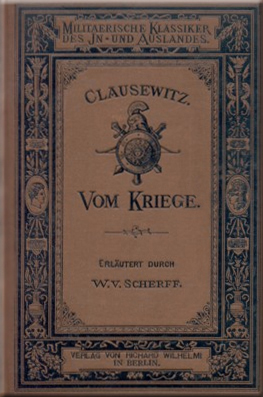
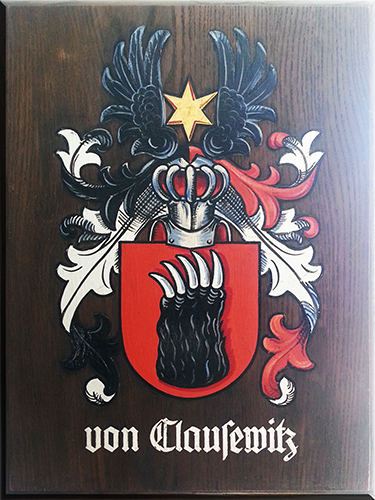 The Clausewitz family coat of arms.
The Clausewitz family coat of arms.
Photo by Vanya Eftimova Bellinger
at the Clausewitz Museum in Burg.
See smaller version.
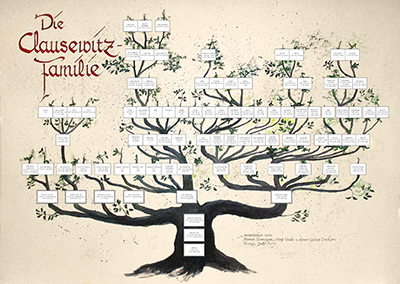 The Clausewitz Family Tree. Click image for a 1300x900-pixel version.
The Clausewitz Family Tree. Click image for a 1300x900-pixel version.
This is a contribution from Olaf Thiel und Bernd Domsgen of The Clausewitz Society
in Clausewitz's hometown of Burg, Germany.
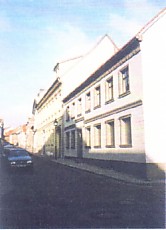 The Clausewitz family house in Burg (restored)
The Clausewitz family house in Burg (restored)
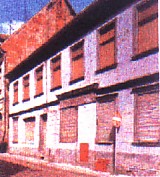 Clausewitz house before restoration.
Clausewitz house before restoration.
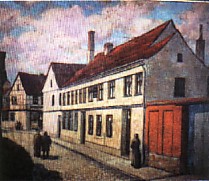 Watercolor.
Watercolor.
Three images (above) of Clausewitz's house in Burg
To see images and a discussion of Clausewitz's military decorations, click on the image below.
Clausewitz Postage Stamps
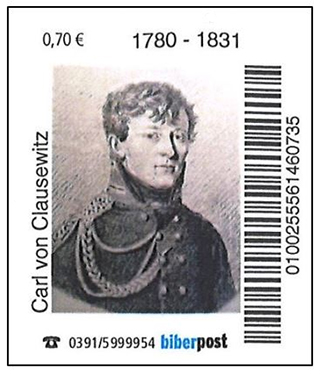
Above: Special stamp issued by "Biberpost" on the occasion of the 240th birthday of Carl von Clausewitz in 2020.
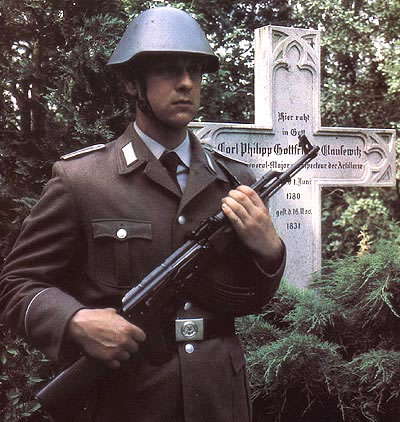 An East German soldier guarding Clausewitz's tomb.
An East German soldier guarding Clausewitz's tomb.
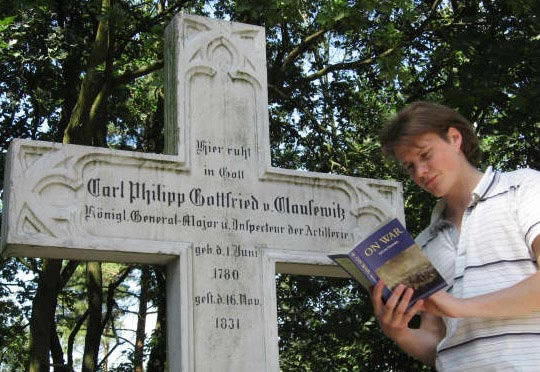 Clausewitz's tomb. Note the correct spelling of the name:
Clausewitz's tomb. Note the correct spelling of the name:
Carl Philipp Gottfried von Clausewitz.
